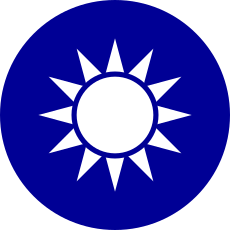Taiwan Province
| Taiwan Province 臺灣省 | |
|---|---|
| Streamlined Province | |
 Taiwan Province of the Republic of China (in red). | |
| Country | Republic of China |
| Established | October 25, 1945 (Retrocession Day) |
| Streamlined | December 21, 1998 |
| Provincial capital |
Taipei (1945-1956) Zhongxing New Village (1956-) |
| Government | |
| • Chairperson | Hsu Jan-yau |
| Area | |
| • Total | 25,110.0037 km2 (9,695.0266 sq mi) |
| Population (2014) | |
| • Total | 7,182,952 |
| • Density | 290/km2 (740/sq mi) |
| Demonym(s) | Taiwanese |
| Time zone | Asia/Taipei (UTC+8) |
| Postal codes | 200–206, 260–369, 500–655, 880–885, 900–983 |
| Area codes | (0)2, (0)3, (0)4, (0)5, (0)6, (0)8 |
| ISO 3166 code | TW |
| Counties | 11 |
| Cities | 3 |
| Website | www.TPG.gov.tw |
| Taiwan Province | |||||||||||||||||||||||||||||||
| Traditional Chinese | 臺灣省 or 台灣省 | ||||||||||||||||||||||||||||||
|---|---|---|---|---|---|---|---|---|---|---|---|---|---|---|---|---|---|---|---|---|---|---|---|---|---|---|---|---|---|---|---|
| Simplified Chinese | 台湾省 | ||||||||||||||||||||||||||||||
| Postal | Taiwan | ||||||||||||||||||||||||||||||
| |||||||||||||||||||||||||||||||
Taiwan Province (Chinese: 臺灣省; pinyin: Táiwān Shěng) is one of the two administrative divisions of the Republic of China (ROC) that are officially referred to as "provinces". The province covers approximately 69% of the actual-controlled territory of the ROC, with around 31% of the total population.
Geographically it covers the majority of the island of Taiwan as well as almost all of its surrounding islands, the largest of which are the Penghu archipelago, Green Island, Xiaoliuqiu Island and Orchid Island. Taiwan Province does not cover territories of the special municipalities of Kaohsiung, New Taipei, Taichung, Tainan, Taipei, and Taoyuan, all of which are located geographically within the main island of Taiwan. It also does not include the counties of Kinmen and Lienchiang, which are located alongside the southeast coast of mainland China and administered as a separate Fujian Province (not to be confused with the PRC's Fujian Province).
Originally Taiwan Province covered the entire island of Taiwan and all its associated islands. All the special municipalities were split off from the province between 1967 and 2014. Since 1997 most of the Taiwan provincial government's functions have been transferred to the central government of the Republic of China following a constitutional amendment. The Taiwan Provincial Government has effectively become a nominal institution under the Executive Yuan's administration.[1][2]
The People's Republic of China (PRC) regards itself as the "successor state" of the Republic of China (ROC), which the PRC claims no longer legitimately exists, following establishment of the PRC in mainland China. The PRC asserts itself to be the sole legitimate government of China, and claims Taiwan as its 23rd province, even though the PRC itself has never had control of Taiwan or other ROC-held territories. The ROC disputes this position, maintaining that it still legitimately exists and that the PRC has not succeeded it to sovereignty.
History
Qing Dynasty
In 1683, Zheng Keshuang (third ruler of the Kingdom of Tungning and a grandson of Koxinga), surrendered to the Qing following a naval engagement with Admiral Shi Lang. The Qing then ruled the Taiwanese archipelago (including Penghu) as Taiwan Prefecture of Fujian Province. In 1875, Taipeh Prefecture was separated from Taiwan Prefecture. In 1885, work commenced under the auspices of Liu Ming-chuan to develop Taiwan into a province. In 1887, the island was declared an independent "Taiwan Province" (officially '''Fujian-Taiwan Province'''), with Liu as the first governor.[3] The province was also reorganized into four prefectures, eleven districts, and three sub-prefectures.[4][5] The provincial capital, or "Taiwan-fu", was intended to be moved from the south (modern-day Tainan) to the more central area of Toatun (modern-day Taichung) in the revamped Taiwan Prefecture.[6] As the new central Taiwan-fu was still under construction, the capital was temporarily moved north to Taipeh (modern-day Taipei), which eventually was designated the provincial capital.
| Divisions of Taiwan Province[7] | |||
|---|---|---|---|
| Circuit | Prefectures | Districts | Sub-Prefectures |
| Taiwan | Taipeh | Tamsui | Kelung |
| Gilan | |||
| Hsinchu | |||
| Taiwan | Taiwan (臺灣縣) | ||
| Changhua | Puli | ||
| Yunlin | |||
| Miaoli | |||
| Tainan | Anping | Penghu | |
| Kagi | |||
| Fengshan | |||
| Hengchun | |||
| Taitung | |||
Empire of Japan
In 1895, the entire Taiwan Province, including Penghu, was ceded to Japan following the First Sino-Japanese War through the Treaty of Shimonoseki. Under Japanese rule, the province was abolished in favour of Japanese-style divisions. After the surrender of Japan in 1945, the Taiwan was handed over to the Republic of China (ROC). The way that the ROC obtained Taiwan is a subject of controversy that gave root to the complex unresolved political status of Taiwan and the Taiwan independence movement.
Republic of China
The ROC government immediately established the Taiwan Provincial Government under first Chief Executive and government-general Chen Yi in September 1945.[8][9] Chen was extremely unpopular and his rule led to an uprising - the February 28 Incident. Chen was recalled in May 1947 and the government-general position was abolished.
When the Republic of China government was relocated to Taipei in 1949 as a result of the Kuomintang's (KMT) defeat by the Chinese Communist Party forces in the Chinese Civil War, the provincial administration remained in place under the claim that the ROC was still the government of all of China even though the opposition argued that it overlapped inefficiently with the national government.
The seat of the provincial government was moved from Taipei to Zhongxing New Village in 1956. Historically, Taiwan Province covers the entire island of Taiwan and all its associated islands. The city of Taipei was split off to become a province-level special municipality in 1967, and the city of Kaohsiung was split off in 1979 to become another special municipality. In December 2010, Kaohsiung County left the province and merged with the original Kaohsiung City to become an expanded Kaohsiung City, Taipei County became the special municipality named New Taipei City. The cities and counties of Taichung and Tainan were also merged, respectively, and elevated to special municipality. On 25 December 2014, Taoyuan County was upgraded into a special municipality and split off from Taiwan Province.
Until 1992, the governor of Taiwan province was appointed by the ROC central government. The office was often a stepping stone to higher office.
In 1992, the post of the governor of the province was opened to election. The then-opposition Democratic Progressive Party (DPP) agreed to retain the province with an elected governor in the hopes of creating a "Yeltsin effect" in which a popular local leader could overwhelm the national government. These hopes proved unfulfilled as then-Kuomintang member James Soong was elected governor of the Taiwan province by a wide margin, defeating the DPP candidate Chen Ding-nan.
In 1997, as the result of an agreement between the KMT and the DPP, the administration of the province was streamlined and curtailed by constitutional changes. For example, the post of provincial governor and the provincial assembly were both abolished and replaced with a nine-member special council. Although the stated purpose was administrative efficiency, Soong and his supporters claim that it was actually intended to destroy James Soong's power base and eliminate him from political life, though it did not have this effect. In addition, the provincial legislature was abolished, while the Legislative Yuan was expanded to include some of the former provincial legislators.
The provincial administration has been greatly streamlined in 1998, and handed most of its power to the central government. The counties and provincial cities under the province then became the primary administrative divisions in the country. In contrast to the past where the head of Taiwan province was considered a major official, the Governor of the Taiwan Provincial Government after 1999 has been considered a very minor position.
Government
Since the streamlining of the Taiwan Provincial Government in 1998, the government has been headed by a provincial council of nine members, led by the provincial governor. The members of the Provincial Council are all appointed by the president. The major operations of the provincial government, such as managing provincial highways and the Bank of Taiwan, have been transferred to the Executive Yuan.
Divisions
Taiwan Province is divided into 11 counties (縣 xiàn) and 3 provincial cities (市 shì) :
| Map | No. | Name | Mandarin (Pinyin) |
Taiwanese (Pe̍h-ōe-jī) | Hakka (Pha̍k-fa-sṳ) | |
|---|---|---|---|---|---|---|
.svg.png) 1 2 3 4 5 6 7 8 9 10 11 12 13 14 |
1 | Changhua County | 彰化縣 | Zhānghuà xiàn | Chiong-hoà koān | Chông-fa yen |
| 2 | Chiayi City | 嘉義市 | Jiāyì shì | Ka-gī chhī | Kâ-ngi sṳ | |
| 3 | Chiayi County | 嘉義縣 | Jiāyì xiàn | Ka-gī koān | Kâ-ngi yen | |
| 4 | Hsinchu City | 新竹市 | Xīnzhú shì | Sin-tek chhī | Sîn-tsuk sṳ | |
| 5 | Hsinchu County | 新竹縣 | Xīnzhú xiàn | Sin-tek koān | Sîn-tsuk yen | |
| 6 | Hualien County | 花蓮縣 | Huālián xiàn | Hoa-liân koān | Fâ-lièn yen | |
| 7 | Keelung City | 基隆市 | Jīlóng shì | Ke-lâng chhī | Kî-lùng sṳ | |
| 8 | Miaoli County | 苗栗縣 | Miáolì xiàn | Biâu-le̍k koān | Mèu-li̍t yen | |
| 9 | Nantou County | 南投縣 | Nántóu xiàn | Lâm-tâu koān | Nàm-thèu yen | |
| 10 | Penghu County | 澎湖縣 | Pénghú xiàn | Phêⁿ-ô͘ koān | Phàng-fù yen | |
| 11 | Pingtung County | 屏東縣 | Píngdōng xiàn | Pîn-tong koān | Phìn-tûng yen | |
| 12 | Taitung County | 臺東縣 | Táidōng xiàn | Tâi-tang koān | Thòi-tûng yen | |
| 13 | Yilan County | 宜蘭縣 | Yílán xiàn | Gî-lân koān | Ngì-làn yen | |
| 14 | Yunlin County | 雲林縣 | Yúnlín xiàn | Hûn-lîm koān | Yùn-lìm yen | |
Note: The cities of Kaohsiung, New Taipei, Taichung, Tainan, Taipei and Taoyuan are administered directly by the central government and are not part of Taiwan province. The Senkaku Islands, which are currently administered by Japan, are disputed by both the ROC and PRC, which claim them as the Tiaoyutai/Diaoyutai Islands. The ROC government claims them as part of Toucheng Township, Yilan County.
Administrative history
Decisions by the Executive Yuan since 1945:
| Date | Division No. | Notes | |
|---|---|---|---|
| Counties | Cities | ||
| December 25, 1945 | 8 | 9 |
|
| August 16, 1950 | 16 | 8 |
|
| December 1, 1951 | 16 | 5 | Downgrade Changhua, Hsinchu, and Pingtung provincial cities to county-controlled cities |
| July 1, 1967 | 16 | 4 | Taipei became the first Taiwanese special municipality |
| November 11, 1967 | 16 | 4 | All county seats (originally towns) upgraded to county-controlled cities. |
| July 1, 1979 | 16 | 3 | Kaohsiung became the second Taiwanese special municipality |
| July 1, 1982 | 16 | 5 | Upgrade Chiayi and Hsinchu to provincial cities (approved on April 23, 1981) |
| December 25, 2010 | 12 | 3 | Upgrade Kaohsiung, New Taipei, Taichung, Tainan to special municipalities, which covers four counties (Kaohsiung, Taipei, Taichung, Tainan) and two provincial cities (Taichung and Tainan). |
| December 25, 2014 | 11 | 3 | Upgrade Taoyuan to special municipality. |
Governor of the Province
Official titles of the governor
| Year | Full title | Literally | Notes | ||
|---|---|---|---|---|---|
| Chinese | Mandarin (Pinyin) | Taiwanese (Pe̍h-ōe-jī) | |||
| 1945–1947 | 臺灣省 行政長官 | Táiwānshěng Xíngzhèng Zhǎngguān | Tâi-oân-séng Hêng-chèng Tióng-Kuaⁿ |
Chief Executive of Taiwan Province | The position of Chief Executive was temporarily part of the Executive Yuan, the position was legalized in Taiwan Provincial Administrative Executive Office Organizational Outline (臺灣省行政長官公署組織條例 Táiwān-shěng xíngzhèng zhǎngguān gōngshǔ zǔzhī tiáolì) of September 20, 1945. |
| 1947–1994 | 臺灣省政府 主席 | Táiwānshěng Zhèngfǔ Zhǔxí | Tâi-oân-séng Chèng-hú Chú-se̍k |
Chairman of Taiwan Provincial Government | After the February 28 Incident, the Administrative Executive Office was reformed to a provincial government. The title often abbreviate as 省主席 shěngzhǔxí. |
| 1994–1998 | 臺灣省 省長 | Táiwānshěng Shěngzhǎng | Tâi-oân-séng Séng-tiúⁿ |
Governor of Taiwan Province | During the democratic reforms, the title "Governor" was first legally used in the Self-Governance Law for Provinces and Counties (省縣自治法) of July 29, 1994. The governor was directly elected by the people of the province. |
| 1998–present | 臺灣省政府 主席 | Táiwānshěng Zhèngfǔ Zhǔxí | Tâi-oân-séng Chèng-hú Chú-se̍k |
Chairman of Taiwan Provincial Government | Since the streamlining of the Taiwan Provincial Government in 1998, the government has been headed by a provincial council of nine members, led by the provincial governor. The members of the Provincial Council are all appointed by the president. The major operations of the provincial government, such as managing provincial highways and the Bank of Taiwan, have been transferred to the Executive Yuan. |
List of Governors
Kuomintang Non-partisan/ unknown Democratic Progressive Party
Chief Executive
| № | Portrait | Name (Birth–Death) |
Term of Office | Political Party | |
|---|---|---|---|---|---|
| 1 |  |
Chen Yi 陳儀 Chén Yí (1883-1950) |
August 29, 1945 | April 22, 1947 | Kuomintang |
Chairperson of the Provincial Government
| № | Portrait | Name (Birth–Death) |
Term of Office | Political Party | |
|---|---|---|---|---|---|
| 1 |  |
Wei Tao-ming 魏道明 Wèi Dàomíng (1899-1978) |
May 16, 1947 | January 5, 1949 | Kuomintang |
| 2 | Chen Cheng 陳誠 Chén Chéng (1897–1965) |
January 5, 1949 | December 21, 1949 | Kuomintang | |
| 3 | 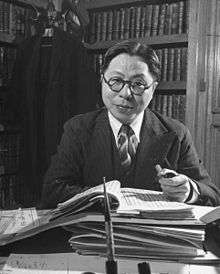 |
K. C. Wu 吳國楨 Wú Guózhēn (1903–1984) |
December 21, 1949 | April 16, 1953 | Kuomintang |
| 4 | O. K. Yui 俞鴻鈞 Yú Hóngjūn (1897–1960) |
April 16, 1953 | June 7, 1954 | Kuomintang | |
| 5 |  |
Yen Chia-kan (C.K. Yen) 嚴家淦 Yán Jiāgàn (1905–1993) |
June 7, 1954 | August 16, 1957 | Kuomintang |
| 6 |  |
Chow Chih-jou 周至柔 Yán Jiāgàn (1899–1986) |
August 16, 1957 | December 1, 1962 | Kuomintang |
| 7 | Huang Chieh 黃杰 Huáng Jié (1902–1995) |
December 1, 1962 | July 5, 1969 | Kuomintang | |
| 8 | Chen Ta-ching 陳大慶 Chén Dàqìng (1904–1973) |
July 5, 1969 | June 6, 1972 | Kuomintang | |
| 9 | 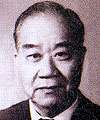 |
Hsieh Tung-min 謝東閔 Xiè Dōngmǐn (1908–2001) |
June 6, 1972 | May 20, 1978 | Kuomintang |
| — | Chu Shao-hwa 瞿韶華 Qú Sháohuá (1914-1996) |
May 20, 1978 | June 11, 1978 | Kuomintang | |
| As acting; Secretary General of the Provincial Government. | |||||
| 10 | Lin Yang-kang 林洋港 Lín Yánggǎng (1927–2013) |
June 12, 1978 | December 5, 1981 | Kuomintang | |
| 11 | 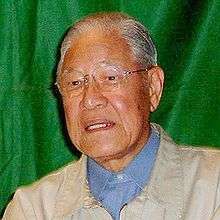 |
Lee Teng-hui 李登輝 Lǐ Dēnghuī (1923–) |
December 5, 1981 | May 20, 1984 | Kuomintang |
| — | Liu Chao-tien 劉兆田 Liú Zhàotián |
May 20, 1984 | June 8, 1984 | Kuomintang | |
| As acting; Secretary General of the Provincial Government. | |||||
| 12 |  |
Chiu Chuang-huan 邱創煥 Qīu Chuànghuàn (1925–) |
June 9, 1984 | June 16, 1990 | Kuomintang |
| 13 | 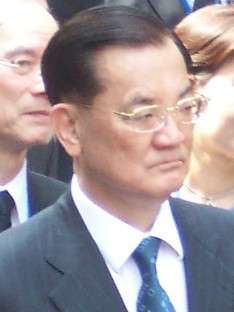 |
Lien Chan 連戰 Lián Zhàn (1936–) |
June 16, 1990 | February 25, 1993 | Kuomintang |
| — | Tu Teh-chi 凃德錡 Tú Déqí |
February 27, 1993 | March 19, 1993 | Kuomintang | |
| As acting; Secretary General of the Provincial Government. | |||||
| 14 | 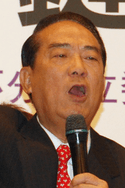 |
James Soong 宋楚瑜 Sòng Chǔyú (1942–) |
March 20, 1993 | December 20, 1994 | Kuomintang |
Governor
| № | Portrait | Name (Birth–Death) |
Term of Office | Political Party | |
|---|---|---|---|---|---|
| 1 |  |
James Soong 宋楚瑜 Sòng Chǔyú (1942–) |
December 20, 1994 | December 21, 1998 | Kuomintang |
Chairperson of the Provincial Government
| № | Portrait | Name (Birth–Death) |
Term of Office | Political Party | |
|---|---|---|---|---|---|
| 15 |  |
Chao Shou-po 趙守博 Sòng Chǔyú (1941–) |
December 21, 1998 | May 2, 2000 | Kuomintang |
| — | Chiang Ching-hsien 江清馦 Jiāng Qīngxiān |
May 2, 2000 | May 19, 2000 | Independent | |
| As acting; Secretary General of the Provincial Government. | |||||
| 16 | Chang Po-ya 張博雅 Zhāng Bóyă (1942-) |
May 20, 2000 | February 1, 2002 | Independent | |
| First female chairperson. Concurrently held post of Minister of the Interior. | |||||
| 17 | Fan Kuang-chun 范光群 Fàn Guāngqún (1939–) |
February 1, 2002 | October 7, 2003 | Democratic Progressive Party | |
| 18 | Lin Kuang-hua 林光華 Lín Guānghuá (1945-) |
October 13, 2003 | January 25, 2006 | Democratic Progressive Party | |
| — | Jeng Peir-fuh 鄭培富 Zhèng Péifù |
January 25, 2006 | December 7, 2007 | Independent | |
| As acting; Secretary General of the Provincial Government. | |||||
| 19 | 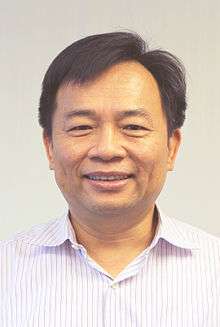 |
Lin Hsi-yao 林錫耀 Lín Xíyào (1961–) |
December 7, 2007 | May 19, 2008 | Democratic Progressive Party |
| Concurrently held post of Minister Without Portfolio. | |||||
| 20 | Tsai Hsun-hsiung 蔡勳雄 Cài Xūnxióng (1941–) |
May 20, 2008 | September 10, 2009 | Kuomintang | |
| Concurrently held post of Minister Without Portfolio. | |||||
| 21 |  |
Chang Jin-fu 張進福 Zhāng Jìnfú (1948–) |
September 10, 2009 | February 26, 2010 | Independent |
| Concurrently held post of Minister Without Portfolio. | |||||
| 22 |  |
Lin Junq-tzer 林政則 Lín Zhèngzé (1944-) |
February 26, 2010 | May 20, 2016 | Kuomintang |
| Concurrently held post of Minister Without Portfolio. | |||||
| 23 | Shih Jun-ji 施俊吉 Shī Jùnjí (1955–) |
May 20, 2016 | June 30, 2016 | ||
| Concurrently held post of Minister Without Portfolio. Shortest serving chairperson. | |||||
| 24 | .jpg) |
Hsu Jan-yau 許璋瑤 (1951–) |
July 1, 2016 | Incumbent | |
| Concurrently held post of Minister Without Portfolio. | |||||
PRC's claims
The PRC claims the entirety of the island of Taiwan and its surrounding islets, including the Penghu, as parts of its Taiwan Province, corresponding to the ROC's Taiwan Province before the special municipalities were split off. The PRC claims that Taiwan is part of China, that the PRC succeeded the ROC as the sole legitimate authority in all of China upon its founding in 1949, and that therefore Taiwan is part of the PRC.
Sister States/Provinces
 Ohio, United States (1985)[10]
Ohio, United States (1985)[10]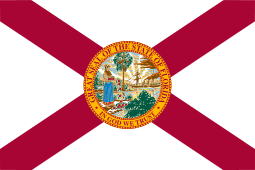 Florida, United States (1992)[11]
Florida, United States (1992)[11]
See also
- Fujian Province, Republic of China
- History of the Republic of China
- Politics of the Republic of China
- Political status of Taiwan
- Chinese Taipei
- "Taiwan, China" - A political term used by China
- Taiwan Province, People's Republic of China
Further reading
- Bush, R. & O'Hanlon, M. (2007). A War Like No Other: The Truth About China's Challenge to America. Wiley. ISBN 0-471-98677-1
- Bush, R. (2006). Untying the Knot: Making Peace in the Taiwan Strait. Brookings Institution Press. ISBN 0-8157-1290-1
- Carpenter, T. (2006). America's Coming War with China: A Collision Course over Taiwan. Palgrave Macmillan. ISBN 1-4039-6841-1
- Cole, B. (2006). Taiwan's Security: History and Prospects. Routledge. ISBN 0-415-36581-3
- Copper, J. (2006). Playing with Fire: The Looming War with China over Taiwan. Praeger Security International General Interest. ISBN 0-275-98888-0
- Federation of American Scientists et al. (2006). Chinese Nuclear Forces and U.S. Nuclear War Planning
- Gill, B. (2007). Rising Star: China's New Security Diplomacy. Brookings Institution Press. ISBN 0-8157-3146-9
- Shirk, S. (2007). China: Fragile Superpower: How China's Internal Politics Could Derail Its Peaceful Rise. Oxford University Press. ISBN 0-19-530609-0
- Tsang, S. (2006). If China Attacks Taiwan: Military Strategy, Politics and Economics. Routledge. ISBN 0-415-40785-0
- Tucker, N.B. (2005). Dangerous Strait: the U.S.-Taiwan-China Crisis. Columbia University Press. ISBN 0-231-13564-5
References
- ↑ 臺灣省政府功能業務與組織調整暫行條例 in Chinese
- ↑ Taiwan Review-Gone with the Times
- ↑ Davidson, James W. (1903). The Island of Formosa, Past and Present : history, people, resources, and commercial prospects : tea, camphor, sugar, gold, coal, sulphur, economical plants, and other productions. London and New York: Macmillan & co. p. 244. OL 6931635M.
During the French war, Liu Ming-chuan had been placed in sole command, responsible only to the central authorities. Under his superintendence, Formosa had been carried safely through the war, and it was now apparent that the exigencies of the times required that the island should be made an independent province, and that officials of high rank and undoubted ability should be henceforth placed in charge of it. Therefore, in 1887, the island was declared by Imperial decree an independent province, and the Imperial Commissioner Liu Ming-chuan was appointed the first governor.
- ↑ Davidson (1903), p. 244: "A thorough reorganization and redivisioning of the island was now necessitated. In former days, Formosa comprised one complete prefecture, four districts, and three sub-prefectures. Now the island became a province with four prefectures (Taipeh, Taiwan, Tainan, and Taitung), eleven districts, and three sub-prefectures."
- ↑ Campbell, William (1915). "Chapter XLIV: A Retrospect and a Forecast". Sketches from Formosa. London: Marshall Brothers. pp. 278–9. OL 7051071M.
- ↑ Davidson (1903), pp. 244-5: "As a result of these changes and additions, the seat of government (which had been formerly at the old town of Taiwan-fu in the south, which city had been in turn the capital of the Dutch, Koxinga, and the Chinese,) was now removed temporarily to the new city of Taipeh, which had been lately in course of construction...In connection with this, it is necessary to go further and explain that it was the intention of the government to build a new capital city in the centre of the island near Changwha. Accordingly, the new city was laid out and the construction of official yamens commenced. The name of the new city became Taiwan-fu, or the capital city of Taiwan (Formosa), and it was also to be the seat of a new prefecture called Taiwan [Prefecture]."
- ↑ adapted from Davidson (1903), p. 244
- ↑ 「去日本化」「再中國化」:戰後台灣文化重建(1945-1947),Chapter 1. publisher: 麥田出版社, author: 黃英哲, December 19, 2007
- ↑ Taiwan History, Chapter 9.The Feb. 28 Incident
- ↑ Welcome to the Ohio Department of Development
- ↑ http://internationalaffairs.flgov.com/pdf/sister.pdf
External links
- Taiwan Provincial Government official site
- Local government structures by the Department of Civil Affairs, Ministry of Interior, ROC
| Wikimedia Commons has media related to Taiwan. |
Coordinates: 23°48′N 121°00′E / 23.8°N 121.0°E
